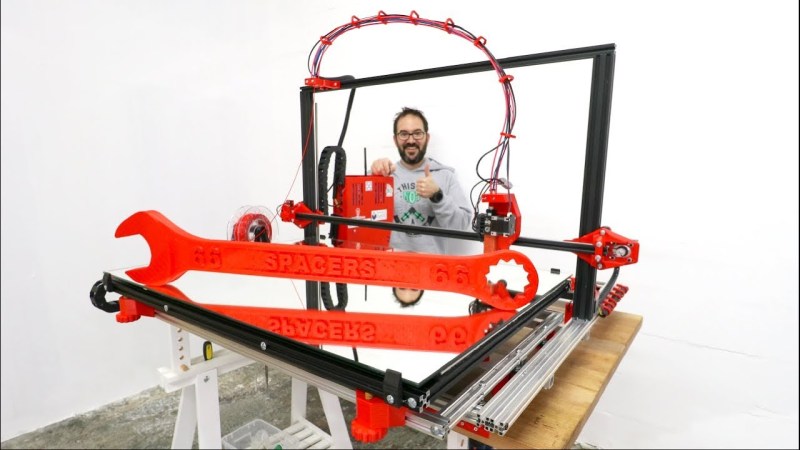Established FDM 3D printers designs generally lead themselves well to being scaled up, as long as you keep frame stiffness, alignment and movement in mind. [Ivan Miranda] needed a big printer for his big projects (videos below), so he built his own i3 style printer with a 800 mm × 500 mm usable print bed and about 500 mm vertical print height.
The frame of the new machine is built using 20×20 and 20×40 aluminium V-slot extrusions with some square tubing for reinforcement. To move all the weight, all 3 axes are driven by double NEMA17 steppers, via a DUET3D board with an expansion board for the extra motors. The extruder is the new E3D Hemera with a 0.8 mm nozzle. The print bed is a mirror, on top of the aluminium plate, headed by a large silicone heat pad. The first bed version used a smaller heat pad directly on the back of the mirror, but it heated up unevenly and the mirror ended up cracking. Look out for the ingeniously lightweight and simple cable management to the extruder. When all was said and done he printed a 800 mm long size 66 wrench as a test piece with zero warp, which is pretty good even for PLA. This project is also a perfect example of the power of 3D printing for rapid iterative development, as lot of the printed fittings went through multiple versions.
Although [Ivan] received most of the components for free, a printer like this is still within reach of the rest of us. We look forward to a lot of big prints by [Ivan] in his signature red, like a massive nerf gun and the ridable tank he is currently working on.















This is an example on how you should study before atempting .. What is the speed ??
*axes *silicone
Sorry, the use of the plural possessive annoyed me a lot, but I ignored it. Silicone and silicon are very different though. Yes….I feel like a jerk, but I know there will be others with eyes twitching :)
Thanks, fixed!
Also “headed by a large silicone”… I think you probably mean “heated”
I believe he’s referring to a silicone heating pad.
Yeah not a “heading” pad :)
It’s got to sting to have this posted a day after The Boat Printer.
when I saw the headline on my rss feed I thought it was going to be a dupe
I don’t envy the filament bill. Great for the environment too.
Aprintapro gives this guy all the red PLA he needs. They even named the color after him. “Mirandament”.
I’ve been building a giant core XY. It’s been…. interesting.
A 66 wrench?
Does that mean the “jaws” are 66mm apart?
Yes. But putting both types of jaws on two ends of the same wrench is annoying when the bold head and nut are the same size.
Hmm. As an old European mechanic fart with an engineering degree I wonder what you use a 66mm wrench for. There are just 60, 65 and 70mm nuts… Never heard of a 66.
Misuse of the phrase “from scratch” aside, this is a great achievement! Next he needs to implement a nurdle-based extruder and make the prints cheaper.
Good old Ivan, the single reason why red PLA suddenly becomes scarce from time to time. :-) (With Josef Prusa it’s Orange. :-) )
any idea of how much a printer like this would cost to build?
I built a 1000x600x450mm 3D printer (independent Z, classic XY on top of that, similar setup to an ultimaker, just with a much beefier mechanical setup and structure). I used integrated rails, 3-phase steppers, 4040 T-slot, lasercut aluminium parts, and integrated rails (from CCM), and the total BOM for the machine was around $15k.
I made a 1 meter diameter, 2 meter tall (work area, not machine total) delta system, using the same types of parts (ordered the BOM at the same time for both), and that delta was around $10k ( so you can see the delta is *much* more efficient cost-wise ( price per print volume ) than the cartesian.
There is a video of the very first print of the delta on my youtube channel (“arthur wolf”, “sleek delta”).
The cartesian is much sturdier/more rigid than the machine this post is describing (the moving Y is going to make a massive difference compared to my setup…), and both machines are able to do high speeds (200mm/s) and acceleration (2000m/ss) while maintaining good print quality, they are “luxury”/”state of the art” machines, not machines meant for minimum budget/cost efficiency.
Now it’s time to print a giant benchy!
Going to need more filament
Brilliant to see some well thought out dedign founded on an understanding of the materials